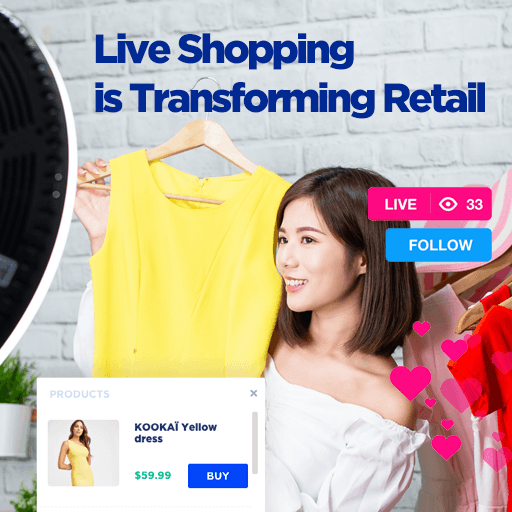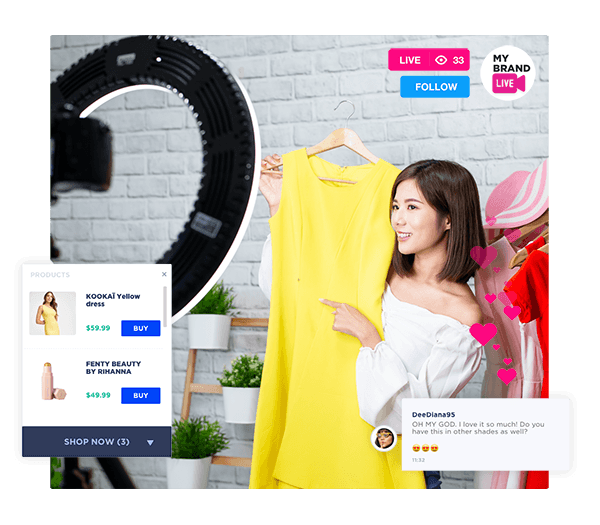
Shopping is quite a new concept in our culture. It’s less than 100 years old. However, most of us were born into it so we take for granted that shopping could either be done in stores or online. But there’s a new kid on the block. It’s called live shopping and it is transforming retail at a very fast pace.
The store was the only place where we could touch and feel products, interact with merchandise and store assistants and eventually purchase goods. The brick and mortar store offered better experiences, human connection and a pastime for many people.
Listen to this article below or continue reading:
But sometimes we want to stay at home or purchase from our offices, our mobile phones. That’s where ecommerce comes into play. It’s easily accessible, products are sometimes cheaper (due to lower cost of logistics) and all we have to do to purchase what we like among thousands and thousands of options is click the “Buy now” button and enter our shipping and payment details. But some things are not quite the same: experiences are rather dull and the human connection is limited to the faces we might see in some website photos.
Until two years ago these were the only options we could choose from. Experience shopping happened in a store while discounts, better prices and a wider assortment of goods were found online. There was no middle ground.
Until live shopping started.

Live shopping is … live but also interactive, social and fun.
Live shopping is a combination of live video streaming and shopping options. The consumer sees a combination of entertainment and shopping features. In the backend the experience is powered by the same logistics that would power the usual ecommerce store.
At the core it allows potential buyers to experience the products in a live, more engaging manner. The presenter/shopping assistant starts off with a basic script on three to ten products they might showcase. As the live session starts they get a sense of what viewers might be interested in and they start taking questions and interacting with the audience.
What changes does live shopping bring to retail?
As the format changes, so does the behavior. It happened with the transition from mom and pop stores to department stores and it happened when the first ecommerce stores started. It happens with live shopping now.
1. Live shopping creates more authentic shopping experiences
Over 90% of millennials consider authenticity as a key factor when choosing a brand they will be loyal to. Yes, brand loyalty is still a thing.
What better format to show your brand’s authenticity than live video. With video conferencing booming in 2020 and continuing its growth in 2021 and beyond, you can make sure that live video will become the norm in the following years.
Live video gives consumers a better perspective on the products they are interested in. It also offers a voice to the brand through the person in front of the camera. The presenters will probably be product savvy but also need to show their true personality in order to be successful at what they do.
2. Social commerce is the the way to go
Using live shopping creates instant engagement from the multitude of visitors watching the stream. Whether there are 50 or 50.000 people watching your live shopping session, they will interact with you. They will ask questions, post messages that are instantly distributed to others, they will react by pressing the “like” or “love” button.
This creates a sense of community, of belonging to a group. It creates a real tribe around your brand and your products. It shapes the conversation through natural discussions rather than dull corporate talk.

Social commerce happens through live shopping
One other thing that social connectivity brings is peer pressure to purchase. As a consumer you know the product offering is not unlimited. You know there are many others watching the same thing as you are. Will the product still be available by the end of the live show? Maybe not. So you press the buy now button. And you purchase.
The purchases in live shopping are deeply social. They are group experiences, entertaining and fun in a way commerce has not been before.
3. New markets can now sell online with live commerce
How would you sell a boat on a traditional ecommerce store? How about a home? Or banking services? Truth is – you couldn’t.
In these markets, as well as others, the decision is not rational. It does involve a rational thought process but it’s more about personal experiences and a feeling of self-expression. You don’t buy a boat because you would starve if you don’t go fishing. You buy it because you think that lifestyle is cool.
A home purchase decision for example is based on many factors and many of those are not rational. Chief among them – emotions. How did you envision your dream house? How do you feel about the agent that’s presenting the property? The factors determining customers to buy a house are social, psychological and demographic. A better photo doesn’t convey us much emotion as a trusted advisor would.
Live shopping is opening many markets that were not traditionally open to selling online. For one – these industries have been affected by the Covid-19 outbreak. But more importantly – they were in need of a new way of selling their goods. A more experience-based tool. And now there is one. Live shopping.
4. Live shopping is a great channel for selling to Millennials and Gen Z’s

Millenials and Gen Z’s start their shopping on live shopping enabled platforms. Source: Big Commerce.
Millennials and Gen Z’s are not starting their purchase journeys (just) on Amazon or Google or their local store. Increasingly they are starting to use Instagram and Snapchat or platforms such as Tik Tok to shop for their favourite products.
Why? Because it’s fun, it’s visually rich and it’s more authentic. These generations spend more time on social media than anything else. Millennials and Gen Z’s spend 3 hours per day on Social Media. This is our native medium now.
It makes sense to create a user journey that’s similar to what they’re used to. And ecommerce stores simply don’t do that today.
5. Live commerce is not your Grandma’s QVC
One of the things I’ve heard many people mention is that Live shopping is (like) QVC. It is not. Just like the Internet was not like a big newspaper. And YouTube was not a big TV Network.
Yes, it uses similar tools but the outcome, due to the interactivity, due to different user demographics, different logistics behind fulfilment of ecommerce is vastly different. Live shopping massively transforms the way we interact and exchange value.
The way live shopping will transform commerce is still hard to grasp but it surely is bigger than QVC.
6. The world gets smaller and retailers are closer to their customers
It doesn’t matter whether you’re selling products from New York, Frankfurt, Tokyo or Beijing. Our way of interacting with one another are similar. The text and photo based internet was unable to grasp the complexity of our interaction but video does. We can watch a foreign speaking live shopping assistant present a product and we will understand what they’re trying to express, even if we don’t speak the language.
Human behaviour is universal and live video transcends the artificial barriers of nations and will further help global trade and connectivity. Our history is a history of means to help trade. Our society has been shaped more by commerce than any other social aspect. Live shopping will surely do the same thing.
7. New life back into brick and mortar stores
Until 2020 there was a term coined that perfectly summed up the fate of brick and mortar stores: The retail apocalypse . Brands such as JC Penney or Neiman Marcus closed in an unexpected manner. The large store chain has been replaced by the large ecommerce store.
The generally accepted idea is that the physical store is dead or dying, especially after the Covid-19 pandemic.
We take a bit of a contrarian view on this: At Streams.live we think that we will see a transformation of the traditional store into something that is even more experience based. We believe the store of the future will be a place where people can experience products, have fun and it will also be a hub of broadcasting to people at home. Yes, fulfilment may be done through means perfected by ecommerce stores but the brick and mortar store will live on as the online-offline hub for live shopping, either in person or online.
8. The store assistant will become the live shopping superstar
The store assistant has long been seen as a dead end job. Now, however, there is a new path forward for charismatic, knowledgeable and not camera shy store associates: the career of being a live shopping assistant.
There are already many superstar live shopping assistants, such as Vyia or Li Jiaqi in China. Li Jiaqi managed to sell $145 million in just one day . Just. One. Day. There is no basketball player or Hollywood star that can drive as much revenue.
If you are a store associate looking for a career, maybe live commerce is an option. The need for such influencers will only be rising. And it’s not the kind you see on Instagram. The new store assistant will know their market really well, they’re trustworthy and they would rather gather a small, but strong community around them. Think of 1000 true fans rather than 100.000 people that just want to see you in a bathing suit.
To conclude – live shopping is changing the world. It’s bringing online industries that have never sold digitally. It’s bridging the gap between online and in store experiences. It’s creating superstars out of ordinary people with extraordinary passion for selling. What do you think it can do for you?





